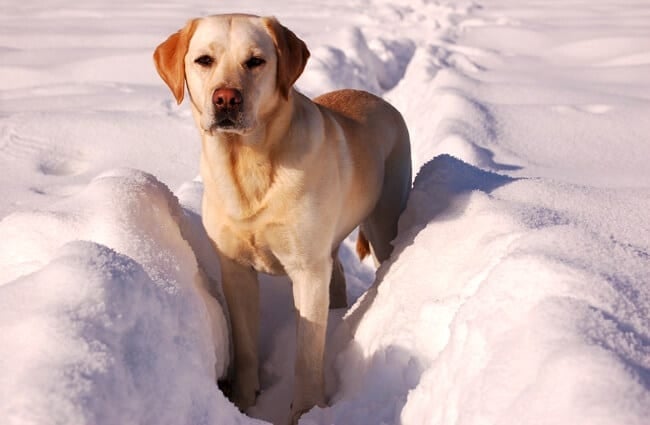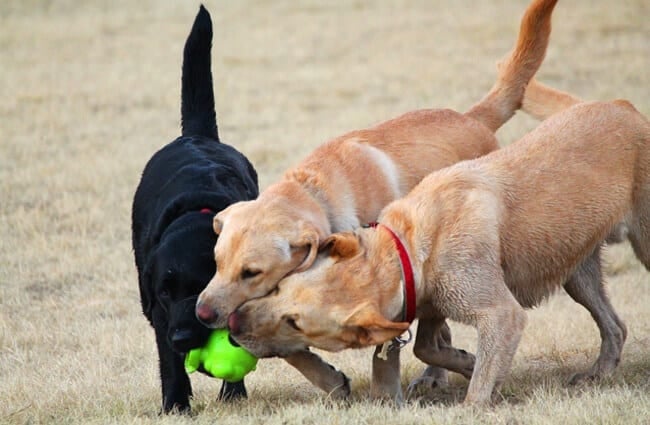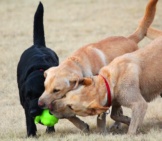The Labrador retriever, often shortened to “Labrador,” or simply “lab,” has been labeled as the most popular breed in the U.S. Despite the name, the breed comes from Newfoundland – not Labrador.
Originally bred as a retriever for hunting and fishing, now the Labrador is often chosen by families for its characteristic loving, gentle temperament. Still, they possess the strength, energy, and loyalty required of hunting dogs. Read more to learn about the Labrador retriever.
Description of the Labrador Retriever
This Labrador retriever is sturdy and athletic, despite sometimes being misrepresented as a chubby couch potato. When fed and exercised properly, their true hunting capabilities come out. As natural retrievers, they can play games like fetch for hours.
The Labrador is a medium to large dog, with short, dense hair and kind eyes. They normally come in three colors: yellow, black, and brown (called “chocolate”) – though some breeders are now producing “silver” labs. Yellow labs can range from nearly white to a rich reddish gold.
Their coats are double layered and water resistant, perfect for swimming. This was especially helpful in the cold, Canadian winters where their short coats prevented icicles from forming. The Labrador retriever also has a specialized tail, which tapers like an otter’s to help them turn in the water.
Life Expectancy and Size
Standard life expectancy for the Labrador is between 10 and 12 years. However, they can face health issues like cancer and epilepsy as they age. Such issues can shorten their lives to 7 or 8 years. Well-bred dogs are less likely to face these issues. Maintaining your Labrador’s exercise, and preventing him from becoming obese can also aid in extending his life.
There is some variation in size between the male and female Labrador. A standard male is between 22.5 and 24.5 inches tall, while the female is about an inch shorter. Males can weigh up to 80 pounds. Females are generally between 55 and 70 pounds.
Protective Ability
Although labs are big and strong, they are also gentle and non-territorial. These sociable dogs are unlikely to show aggression towards people or dogs. However, these traits make the Labrador retriever a great option for a family dog, even if they are not well suited to guarding.
Training
The Labrador is intelligent and notoriously food-loving. This can make them quick, efficient learners.
Many labs are used for important tasks such as bomb detection and as service dogs. Their innate love of retrieval also makes them great hunting dogs, even if this is no longer their most common job. They also are well suited to agility and obedience. Labs are almost always amazing swimmers!
However, remember that the Labrador has a lot of strength and energy. This means that they do best when training is initiated at a young age. Creating a foundation in reward- and relationship-based training can ensure that they mature into loving, manageable adults that are able to channel their energy properly. Resorting to correction-based training is often ineffective, and ignores the breed’s natural desire to please.
Energy Level
The Labrador has become such a popular family pet that it is often forgotten to be an athletic and energetic breed. These dogs need large amounts of exercise to stay healthy and sane. Ideally, long walks on forested tracks or field trails allow them to use up their energy and strengthens their muscles. This can help them live longer and avoid complications due to obesity.
Often, young labs remain exuberant long after puppyhood, up to three years! Adequate exercise can help alleviate any unwanted behaviors that arise from boredom.
What Living with a Labrador Retriever is Like
The Labrador is an incredibly popular dog for good reason. The breed is friendly, sociable, and gentle. These traits make them lovely family pets, particularly in homes with plenty of places for them to run and play. Small spaces, or situations where they are often left without company, are ill-advised.
The breed is especially well-suited to families that allow them to participate in activities. They enjoy being active, and easily make bonds with multiple family members. Labs want to join in on the fun, and may become bored or even destructive if they are not given adequate opportunities to use up their energy.
Labs are generally good for households with kids. However, they can be rowdy for their first few years, accidentally knocking over their playmates in their exuberance. Older dogs may do better with very young children.
Well cared-for and responsibly bred labs often live long, healthy lives. However, some suffer with health issues, and may only live to be 7 or 8 years, especially if they are allowed to become overweight.
Care of the Labrador Retriever
This breed is tough and adaptable. Besides the need for high levels of exercise, Labs are relatively easy to care for, and may suit a variety of situations.
Environmental Needs
Bred for the harsh Canadian climate, the Labrador does well in most environments. Their short, dense hair allows them to comfortably swim in even the coldest conditions. They tolerate heat as well, although they should be provided with sufficient sun protection and sources of water. Their high energy and sturdy build means that they enjoy spending plenty of time outdoors in most situations.
Exercise Needs
Providing the breed with adequate exercise is one of the most important aspects of the Labrador’s care. Although they enjoy interacting with the family, lounging around in the yard is not enough to keep them happy and healthy. Many health problems associated with the Labrador, including hip and heart issues, are more likely to develop when the breed becomes unfit.
These dogs should have extended periods of walking, jogging, or other structured exercise daily. Swimming is an ideal form of exercise for the breed, and you’ll likely find it is their favorite pastime! Jobs in which they are asked to work with humans, such as agility, hunting, search and rescue, and other searching are especially good. These not only provide sufficient exercise, they also give these intelligent dogs something to think about.
Shedding and Grooming
Although the Lab’s short, double-layered coat is very versatile and effective at repelling water, it also sheds – profusely. This breed may not be a good option for people with allergies, or those who do not like to vacuum.
Grooming routines for the Labrador are straightforward. They require minimal, weekly brushing and occasional baths. Their nails should be trimmed, and their teeth brushed regularly, just like other dogs.
Ideal Home Environment
The Labrador is a great companion for the active individual or family. Their sociable nature makes them ideal for large households, or those with other pets. They could also be the perfect fit for owners interested in their abilities to perform tasks, like hunting. Labs also often flourish as service animals.
This kind, happy-go-lucky breed is a versatile addition to most situations that can provide loving support, and sufficient mental and physical activity.
Health Concerns
Labs are generally healthy, especially those from a responsible breeder. Most health problems can be avoided through breeder DNA testing, and by taking positive steps to keep your lab in shape.
Common issues include elbow and hip dysplasia, retinal atrophy, and heart problems. A condition called exercise induced collapse, or “EIC,” is another concern. The breeder may use DNA or other tests to avoid puppies with this problems.
Some labs face health concerns as they age. These can include bone and joint pain, and cancer. Although they may be impossible to avoid, poorly bred and obese dogs may be at greater risk. Cancer is devastatingly common with this breed as they age.
Bloat, a potentially deadly stomach problem in which the stomach twists inside the chest cavity, affects labs and other dogs of similar stature.
Behavior Problems
The Labrador is generally well behaved if properly exercised. Most problems, like barking and chewing, arise when the dogs are being under stimulated. It’s important to remember that bored and lonely dogs cause problems.
The breed is especially energetic in the first few years. This means that starting a rewards-based training program at a young age is essential to avoid unwanted behaviors. Additionally, providing the dogs copious amounts of exercise will help to keep them out of trouble.
Chew toys may be able to help with any excessive gnawing. These can be particularly useful when labs are home alone and may become bored or anxious.














![Red Angus Closeup of a beautiful Red Angus cowPhoto by: U.S. Department of Agriculture [pubic domain]https://creativecommons.org/licenses/by/2.0/](https://animals.net/wp-content/uploads/2020/03/Red-Angus-4-100x75.jpg)

